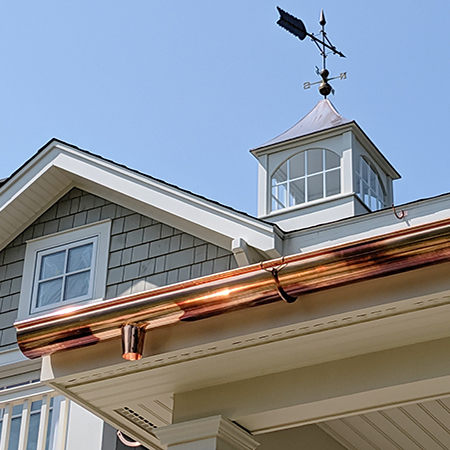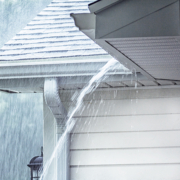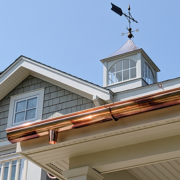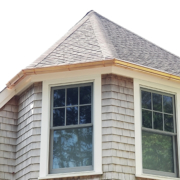Often overlooked and underappreciated, gutters play an important role in protecting your home and property from water damage. When functioning properly, gutters direct rainwater away from your house efficiently, safeguarding your foundation, roof, and landscaping. However, all gutters have a lifespan, as well as the potential for damage under certain conditions. Neglecting a necessary gutter repair can lead to costly consequences. Below are several reasons why homeowners should have regular professional gutter inspections and not postpone an essential gutter repair.

Prevent Damage
One of the most compelling reasons not to delay gutter repairs is to prevent damage to your home. When gutters become damaged or clogged, rainwater cannot flow as intended. Instead, it may overflow, leading to water seepage into your home’s foundation, walls, and possibly even lower parts of your roof. This can result in expensive structural damage, including foundation cracks, rotting wood, and water stains. By addressing gutter issues promptly, you can mitigate the risk of these costly repairs and ensure that your home remains structurally sound.
One of the best ways to prevent future damage is to regularly clean your gutters. If you have your gutters cleaned professionally, your gutter specialist can do regular on-site inspections and identify any potential problems early, before they become a big issue.
Protect Your Roof
Your roof is one of the most critical components of your home’s structure, and gutters are your first line of defense against water damage. Clogged or damaged gutters can cause water to pool on your roof, leading to leaks, shingle damage, and even structural problems. Timely gutter repairs help to safeguard your roof, extend its lifespan, and prevent the need for costly roof repairs or replacements.
Preserve Landscaping
Well-maintained gutters protect your landscaping by directing rainwater away from your flowerbeds, shrubs, mulched gardens, and grass. Neglected gutter issues can lead to water pouring directly onto your landscaping, causing soil erosion, root damage, and even the loss of plants, shrubs, and other greenery. A well-functioning gutter system can help preserve your home’s curb appeal and the value of your property.
Prevent Mold and Mildew Growth
Excess moisture in and around your home can create a breeding ground for mold and mildew. When gutters are not functioning correctly, water can seep into your walls and foundation, creating a damp environment that can promote the growth of these harmful substances. Mold and mildew not only compromise indoor air quality but can also require costly remediation efforts. By addressing gutter issues promptly, homeowners can reduce the risk of mold and mildew infestations.
Reduce Pest Infestations
Clogged gutters can also become a breeding ground for pests such as mosquitoes, rodents, and insects. Allowing water to pool in gutters (called standing water) can provide an ideal environment for unwanted guests to thrive. By postponing a necessary gutter repair, you are essentially creating the potential for pests to eventually find their way into your home. Timely maintenance and repairs ensure that your gutters remain pest-free and allow for a healthier living environment all around.
Prevent Ice Dams
Here in the Northeast, ice dams can be a significant problem. Ice dams happen when a snow or ice storm occurs and snow and ice accumulate on your roof. The risk of ice dam formation increases when gutters are clogged or damaged, preventing proper drainage. These ice dams can lead to water infiltration and damage to your home’s interior. Timely gutter repairs are essential to prevent ice dams and the subsequent damage they can cause. For more information on ice dams, see our article here.
Preserve the Value of Your Home
Maintaining your gutters is an integral part of home maintenance. When gutter maintenance is deferred, your home’s value can depreciate. Potential buyers and appraisers often consider the condition of gutters as a reflection of the overall care and maintenance of the property. Keeping your gutters in excellent condition helps to preserve the value of your home, making it more appealing to future buyers.
Avoid Emergency Repairs
Postponing a gutter repair can lead to a potential emergency situation that is more extensive and disruptive to your daily life. A leaky roof, water infiltration, or structural damage due to neglected gutters can necessitate immediate and costly repairs. Avoid the stress and financial strain of emergency repairs by addressing a gutter issue as soon as you become aware of it.
One of the best ways to avoid damage is to have your gutters cleaned regularly. A good gutter specialist will also inspect your gutters to identify and address any potential problems. Homeowners should also not underestimate the importance of timely gutter repairs. Neglected gutter maintenance can lead to a host of problems, from structural damage and roof issues to mold infestations and landscape degradation.
By keeping your gutters clean and addressing gutter problems promptly, you can protect your home, prevent further damage, and maintain your property’s value. Take proactive and routine care of your gutters to ensure a safe, dry, and structurally sound home and property.

Every house has fascia boards. So what are they? Fascia boards are long wooden boards attached to the rafters on a roof, and they run along the base of the attic. As part of a roof system, gutters mount onto fascia boards, securing them in place. Fascia boards block water from penetrating a roof deck, but they also serve to increase curb appeal.
What Material is Used to Make Fascia Boards?
In residential homes, fascia boards are largely made out of wood. They can be made out of steel or aluminum in some commercial applications. Composite fascia boards are also produced but not commonly used.
What Can Cause Fascia Boards to Fail?
Because residential fascia boards are mostly made out of wood, they are susceptible to deterioration when poor gutter and/or roof conditions allow moisture to persist. This can happen when a roof has not been installed properly. Over time, fascia boards can begin to fail, causing rot. Aging roofs, poorly-designed homes or damaged shingles can also allow unwanted water conditions, causing damage to fascia boards.
What Gutter Problems Can Lead to Fascia Board Failure?
Improperly Installed Gutters
Properly-installed gutters are designed to slope slightly toward their outside edges. In this case, if water overflow occurs it can release away from fascia boards. Improperly-mounted gutter systems, however, can cause water damage to fascia boards by allowing water to flow over the gutters’ inside edges toward fascia boards.
Clogged Gutters or Downspouts
If gutters remain blocked for too long, water can back up and begin to overflow. Downspouts clogged with leaves, sticks and other debris can also cause gutters to back up, resulting in water damage to fascia boards.
Do Compromised Fascia Boards Need to Be Replaced?
Once moisture has penetrated fascia boards, they must be replaced. Fascia board replacement is especially important to prevent further water damage to the walls and foundation of your home.
The Good News About Replacing Fascia Boards
Fascia boards are somewhat easy to replace since they are one of the last materials to be installed on the exterior of a house. To get to fascia boards, the only materials that need to be removed first are gutters.
Prevent Your Fascia Boards From Failing
A solid gutter system combined with proper roof installation will help to prevent fascia boards from eroding. Using the proper nails and fasteners when installing gutters is equally important to prevent gutters from pulling away from fascia boards. When this happens, water can run off behind gutters and bounce onto fascia boards. The following two actions will help to prevent fascia board failure.
Use a Sealant
Protect your fascia boards with a sealer or good quality exterior paint. Fascia boards will unavoidably get wet when precipitation occurs but sealing fascia boards will act as ongoing protective barriers. Bear in mind that as the products wear, you will need to paint or seal your fascia boards again.
Inspect Fascia Boards and Gutters Regularly
Your gutters should be inspected routinely to ensure they are functioning properly. We recommend having them inspected by a licensed professional such as The Gutter Specialist at least twice each year. At that time, your gutter professional will also inspect your fascia boards to determine if they have been subjected to prolonged moisture problems or deterioration. Taking these steps will go a long way toward preventing damage to fascia boards.
 Circumstances vary around gutter systems, so every situation is different. In certain cases, delaying gutter replacement could compromise roofing or the foundation, causing further damage to the property and creating other problems.
Circumstances vary around gutter systems, so every situation is different. In certain cases, delaying gutter replacement could compromise roofing or the foundation, causing further damage to the property and creating other problems.
If you can wait, though, the summer and fall seasons are a great time to tackle gutter replacement. It rains less in summer and fall than in the spring. Even when it does rain in the summer, warmer temperatures dry off rainwater more quickly. This means shorter delays for your project.
The spring season is a great time for assessing the current condition of your gutters. Since showers are frequent during this time of the year, it is likely that your gutter system will take on large quantities of water. This offers a great opportunity for you to test out your gutters to see if they are still capable of draining water efficiently. You can also use this season to plan for gutter installation. Although the job is usually a straightforward process, there should still be sufficient planning before starting the project.
Several factors determine the best time for gutter replacement. Depending on the reason or how urgent the situation, sometimes gutters need to be replaced sooner. The timing depends on your purpose. Below are some factors that will help you decide when you should install new gutters.
New Roof Installation
A great time to install new gutters is when a roof is also being replaced. If your roof has reached the end of its lifespan, you might want to check your gutters as well. It might be time to replace those, too. Having brand new gutters will ensure that they are in the best shape to protect your new roof from water damage.
Selling Your Home
Gutters may not be the most significant factor in curb appeal, but they can certainly make a big difference to the appearance of your home’s exterior. And, sometimes, these minor details can make all the difference to potential homebuyers. So, if you are planning on selling your home soon, you should check your gutters for any noticeable damage like hail marks, cracks or discoloration. Make sure that the sections aren’t pulling away. It’s also important to fix any gutter issues before putting your home on the market.
Mold Problems
The presence of mold in any part of your home can be sign of gutter deterioration. If you have any mold conditions in your home, have your gutter system inspected by a licensed professional. You may have unknown leaks that are allowing water to enter your home. They can assess the condition of your gutters and recommend the best approach.
Rusty Gutters
If your gutter material is metal, you should look for signs of corrosion. Metal gutters typically get rusty as they age, and this can create small pinhole leaks and large holes over time. Depending on the extent of damage, you may only need to replace one section or your entire gutter system.
Preparing for the Wet Season
Your gutter system is critical to keeping rainwater away from your roof. If your gutters have already been showing signs of damage or deterioration, you should have them replaced before the wet season arrives.
Who Should Perform Gutter Installation?
Some homeowners are confident in tackling a DIY gutter installation, but it is usually recommended to leave the job to experienced professionals. This will ensure the best outcome. Remember that your gutters are crucial to protecting your home from water damage. Any mistake during the installation process could compromise its quality and performance. To ensure that your gutter system can really withstand the elements, hire a professional.
Even with regular maintenance, the elements can degrade your gutters over time. We recommend that you inspect your drainage system for trouble spots at least once a year. And when necessary, take the following preventative measures to protect your drainage system.
Remove Rust
It is important to treat any rust before it does serious damage to your gutter. Remove light rust with a wire brush and be sure to flush or vacuum the resulting debris. You can also use a rust-removing solvent before power-washing your gutters.
Inspect Your Gutters for Leaks
Leaks are generally apparent during rainstorms and snowmelt, but you can also inspect for them by pouring a bucket or two of water into strategic areas of your gutter system. Leaky seams should be sealed with a caulking compound, while small holes can be patched with roofing cement. If a segment of gutter is especially leaky, it may warrant replacing.
Reline Your Gutter
After fixing leaks and removing rust, you should consider relining your gutter with a rubber sealant. A quality rubber sealant can protect gutters from rust, maintain seam integrity and facilitate better drainage.
Install Gutter Screens
If your building is located in an area with lots of trees or other sources of debris, you may choose to install gutter screens. These devices range from simple metal grates to nylon screens to foam filters.
Trim Surrounding Trees
At least once a year, you should trim any overhanging tree branches to reduce the number of leaves ending up in your gutter in the fall.
Clean Your Roof
Keeping your roof clean is a good idea for a variety of reasons. One of them is that the more debris that’s on your roof, the more that will find its way into your gutters.
Check Gutter Pitch
Test your gutter pitch by pouring a bucket of water into your gutters, to ensure that they remain properly sloped and water is draining.
Assess Damage
If you gutter health has declined to a severe extent, it’s probably time to call a professional to ensure damage is repaired properly.
During winter, precipitation combined with freezing and thawing cycles can create ice conditions in and around gutters. Some homeowners use rock salt to break up these ice dams. But homeowners should take caution before doing this as salt can cause damage to the exterior of your home.
Why Ice Dams Occur
After a heavy snowfall and several days of sub-freezing temperatures, warm air inside a building or home can warm the underside of a roof, causing snow and ice on the roof to melt. The melted water can drain along the roof, under the snow, until it reaches the cold eve overhang. The eve overhang usually remains the same temperature as the outdoors, and the melted water will refreeze and form an ice dam.
Depending on the design of your home, ice dams may not be an issue, and allowing the ice to melt may be sufficient if you are not experiencing damage that warrants immediate action. Conversely, if water is leaking down the side of your house, then the decision process of what to do must be carefully evaluated.
There are five commonly used types of ice melt (also known as rock salt):
sodium chloride
magnesium chloride
calcium chloride
potassium chloride
acetates
Rock salt in all forms is corrosive. It can cause many kinds of damage including gutters, metal flashings and downspouts. It can also damage roofing and siding, and it can change the color of your shingles.
In addition, runoff from rock salt dissolved in rainwater can weaken or kill foundation plants, grasses, shrubs and the roots of perennial flowering plants. These harmful effects can be magnified if the salt product you use has a combination of chemicals in it, as is often the case.
Many ice melt products rely on sodium chloride. This is the type that can leave stains on a driveway and sidewalk, rust the underside of cars and destroy grass. It is also known to be dangerous to pets. Magnesium chloride is the type of salt that is generally thought to be less corrosive.
If you do decide to add rock salt to your gutters, choosing your ice melt product carefully and using it sparingly is advised. However, calling a professional is a best practice that can save many headaches from unintended home damage.
Gutters and downspouts work tirelessly year-after-year to channel storm water away from homes. And although yours may have contributed decades of faithful, mostly trouble-free service, every installation has an expiration date.
Here are some common signs that your gutters may be approaching the end of their useful life.
Cracking
Cracked gutters can result in water leakage in unwanted places. While larger cracks can be plainly visible, smaller ones may only become apparent during rainfall. Regardless of the size, cracks defeat the purpose of a drainage system and need to be taken seriously. Individual cracks may be repaired, but extensive cracking is a reason to consider replacement.
Seam Stress
Average gutters are vulnerable at the seams where two sections meet. Both leaks and separations are common, with each type of failure leading to any number of undesirable outcomes, whether outside or inside the home.
Peeling Paint
Malfunctioning gutters can ruin a perfectly good paint job. Check your exterior siding for any paint that has bubbled up or peeled away due to excess moisture. If you find an area of compromised paint, be sure to check the condition of the nearest gutter. You may have a leak.
Rot
When failing gutters allow rain to cascade over the siding of a home, exterior wood trim elements like window sills and door jambs become moisture soaked as well. When this happens, drywall can also damage the inside of your home.
Mold
Mold can be a serious condition that affects the health of the inhabitants of a home. Water accumulating near a foundation can leak into the basement and cause unhealthy mold growth. If you discover mold in a formerly dry area, damaged gutters are the likely cause.
Gutters perform important work to protect structures, but when they show any signs of the above conditions, it may be time to look at a new installation.

The Highest Quality Gutter Protection for Your Home
Call Today: 860-876-2227
Providing gutter installation and maintenance services to New Haven, Middlesex, and New London Counties
© Copyright 2024 The Gutter Specialist, All Rights reserved | Licensed #HIC 0643225 | Fully Insured







